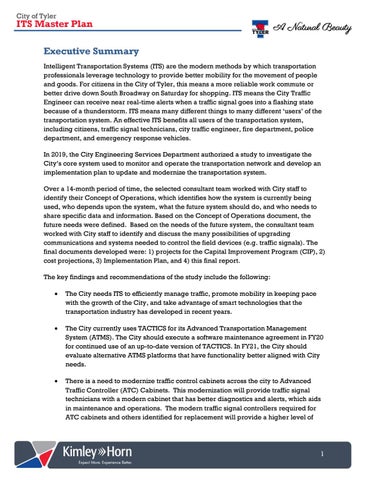City of Tyler
ITS Master Plan Executive Summary Intelligent Transportation Systems (ITS) are the modern methods by which transportation professionals leverage technology to provide better mobility for the movement of people and goods. For citizens in the City of Tyler, this means a more reliable work commute or better drive down South Broadway on Saturday for shopping. ITS means the City Traffic Engineer can receive near real-time alerts when a traffic signal goes into a flashing state because of a thunderstorm. ITS means many different things to many different ‘users’ of the transportation system. An effective ITS benefits all users of the transportation system, including citizens, traffic signal technicians, city traffic engineer, fire department, police department, and emergency response vehicles. In 2019, the City Engineering Services Department authorized a study to investigate the City’s core system used to monitor and operate the transportation network and develop an implementation plan to update and modernize the transportation system. Over a 14-month period of time, the selected consultant team worked with City staff to identify their Concept of Operations, which identifies how the system is currently being used, who depends upon the system, what the future system should do, and who needs to share specific data and information. Based on the Concept of Operations document, the future needs were defined. Based on the needs of the future system, the consultant team worked with City staff to identify and discuss the many possibilities of upgrading communications and systems needed to control the field devices (e.g. traffic signals). The final documents developed were: 1) projects for the Capital Improvement Program (CIP), 2) cost projections, 3) Implementation Plan, and 4) this final report. The key findings and recommendations of the study include the following: •
The City needs ITS to efficiently manage traffic, promote mobility in keeping pace with the growth of the City, and take advantage of smart technologies that the transportation industry has developed in recent years.
•
The City currently uses TACTICS for its Advanced Transportation Management System (ATMS). The City should execute a software maintenance agreement in FY20 for continued use of an up-to-date version of TACTICS. In FY21, the City should evaluate alternative ATMS platforms that have functionality better aligned with City needs.
•
There is a need to modernize traffic control cabinets across the city to Advanced Traffic Controller (ATC) Cabinets. This modernization will provide traffic signal technicians with a modern cabinet that has better diagnostics and alerts, which aids in maintenance and operations. The modern traffic signal controllers required for ATC cabinets and others identified for replacement will provide a higher level of
1


